The food pyramid helps organize a person’s nutrition in such a way that he can not only get rid of excess subcutaneous fat, but also normalize the functioning of the body’s internal systems. Nutritionists select a specific type of food pyramid taking into account the patient’s age, the characteristics of his physical condition (pregnancy, lactation) and the presence of health contraindications.
By following the main steps of a correctly individually designed scheme, a person will be able to achieve visible results in transformation without setting strict limits for himself in nutrition and usual lifestyle.
How to use the food pyramid?
Knowing at what level which product is located, all that remains is to introduce it into the diet in the required proportions.
The developers of the pyramid give some advice on its use:
- All products in it are important (except for the top tier). It is not recommended to exclude them from the diet, trying to compensate with other foods.
- By physical activity we mean not only fitness and other sports activities, but also walking and everyday movements (for example, at work).
- It is better to combine products. For example, cereals and vegetables go well with white meat and seafood.
Whole grain products
The right carbohydrates should be your main source of energy, just like fiber or vitamins. They must be consumed at least twice a day, for example, a bowl of porridge for breakfast and a plate of pasta for dinner. The word “carbohydrates” inspires fear in many people; just reading it seems to cause weight gain. In fact, if you eat the right carbohydrates and reduce the amount of unhealthy foods (butter, which won’t ruin your porridge, but can help your figure, gravy, sugar), then you can even lose weight.
Vegetables and fruits
They must be used correctly:
Variety is important. You can divide the fruits by day, for example, have Apple Mondays, Banana Tuesdays, Orange Wednesdays, etc. Especially useful are foods rich in vitamins A (cabbage, carrots), C (kiwi, lemon). In winter you can cook frozen vegetables and fruits
Considering that they were grown exactly in their season, sometimes they are even healthier than fresh ones.
Where do you get protein from?
It is known that protein is the main building material for muscles. But you need to get it from the right foods:
- Birds. The “safest” are goose, duck, and turkey.
- Seafood. You can prepare a salad with squid, rice with shrimp.
- Low-fat fish. Cod and grilled tuna are suitable.
- Bobovykh. Beans, chickpeas, peas, lentils.
- Lean meats. It is recommended to choose not only the type of meat, but also a certain part of it, for example, beef tenderloin or fillet, lamb shoulder, veal escalope.
Products from this group should be eaten twice a day.
Dairy
In addition to milk itself, you can supplement your diet with its derivatives, taking into account how many products are contained in one serving:
- Ryazhenka, cream, kefir - 1 glass.
- Hard cheese – 50-60 g.
- Cottage cheese - a third of a pack.
Fats
Fats are a reserve of energy, which is why they are also important. There is such a classification:
- Monounsaturated. Olives, peanuts.
- Polyunsaturated. Corn, fish oil, soy.
- Saturated. Milk, meat.
The latter should be the least in the diet
It is also important to maintain a balance of reinforced concrete products. It is not recommended to consume only fats; you need to supplement them, for example, with carbohydrates
Basic principles of proper nutrition
Our body needs a balance of proteins, fats and carbohydrates for normal development. Vitamins and minerals - to maintain tone, fiber - for the digestive system to function properly.
Photo: Depositphotos
Here are the basic principles of healthy eating that will help you create the right menu.
Important elements of a healthy diet
- Carbohydrates are the main source of energy for humans. They are rich in vegetables, whole grains, and fruits. The daily volume should mainly consist of complex “slow” carbohydrates. They supply the body with energy evenly throughout the day. But “fast” carbohydrates need to be reduced to a minimum - these are empty, useless calories that provoke sharp surges in blood sugar. And in large quantities they threaten to become overweight.
- Protein provides energy, increases muscle mass, and is responsible for mood, memory and mental performance. As a person ages, they need more high-quality protein. This does not mean that you need to eat more meat - vegetable protein will supplement the required amount.
- Healthy omega-3 and omega-6 fats protect the brain and heart. They are vital for physical and emotional health: they improve mood, give tone and even get rid of extra centimeters on the waist. However, not all fats are created equal. Some of them contain saturated acids - these are solid compounds that the body does not absorb well. In large quantities, they increase the risk of developing diseases.
- Fiber, otherwise known as dietary fiber. It is rich in grains, fruits, vegetables, nuts, and legumes. Dietary fiber normalizes the functioning of the digestive tract, reduces the risk of cardiovascular diseases, strokes, and diabetes. Fiber-rich foods improve skin condition and help you lose weight.
- Calcium. Foods rich in this mineral should be included in the diet at any age. At the same time, you need to get enough magnesium, vitamins D and K so that calcium is fully absorbed and performs its functions in the body. A deficiency of the element leads to osteoporosis, causes anxiety, depression and disrupts sleep. Therefore, limit the amount of food that leaches calcium.
Important: sick people need to take into account the characteristics of their body and adjust the nutritional system to suit themselves. For example, too much protein can harm people with kidney disease.
Moderation in food is an important rule of healthy eating.
The basis of healthy eating is the principle - do not overeat! The fact is that the signal of saturation does not immediately reach the brain, and we do not feel when it is time to stop. Especially if the food looks and smells delicious and we are hungry. It is necessary to take into account this feature of our body and the calorie content of dishes. And choose a portion that will allow you to be full, but not overeat. Here are a few techniques that will help you adjust the amount of food you eat and learn to catch the moment of fullness.
- Nutritionists recommend stretching out your meals for at least half an hour: chewing your food slowly and thoroughly. Use your teeth, tongue and palate to fully experience the taste of the dish. During this time, a signal of satiety will be sent to the brain.
- Until controlling the amount of food you eat becomes a habit, try to eat familiar foods. The fact is that new taste sensations dull the feeling of fullness and it is easy to overeat if the dish is tasty.
- A serving of meat, fish or chicken should be the size of a deck of cards, and the side dish should be the size of a regular light bulb.
- Serve food on small plates. This way you will “deceive” your brain, which knows that you need to eat the whole portion. If you feel hungry at the end of your meal, add a green salad or end your meal with a piece of fruit.
- Eating with a book, in front of the TV or computer leads to unconscious overeating: the brain is busy processing information, and we miss the signal of satiety.
- Analyze your emotional state. We don't always eat to satisfy our hunger. Many people eat stress, sadness, loneliness or boredom.
- Try not to snack between meals.
- Keep track of the foods you keep on hand. It is much more difficult to maintain moderation if there are unhealthy snacks and sweets in the access area. Instead, surround yourself with healthy foods: vegetables, fruits, berries. Even as a snack, they will only bring benefits.
Stick to a specific diet
It is important to control not only the menu, but also the diet - eat at the same time. Then the body will get used to producing gastric juice and necessary hormones at certain hours. This means that the digestive system will work without failures and every cell of the body will receive its nutrition on time. It doesn’t matter whether you stick to a traditional 3-times-a-day diet or a fractional 5-times-a-day diet.
Be sure to have breakfast. A healthy breakfast will start your metabolism and provide your body with energy for a long time.
Avoid late dinners. There should be a gap of one and a half to two hours between the last meal and bedtime. If you feel hungry, drink a glass of low-fat milk or kefir at night.
Add more fruits and vegetables to your diet
Fruits and vegetables contain fewer calories and more nutrients: vitamins, minerals, antioxidants, fiber. Eat fruits or vegetables 5 times a day and you will lose weight without any extra effort.
One dose is roughly half a glass of fresh fruit. For example, a small apple, a banana, two tablespoons of vegetable salad.
If you don't have enough vegetables and fruits in your diet, here's how you can increase your usual intake:
- add antioxidant-rich berries to your favorite breakfast cereal;
- eat a mixture of sweet fruits for dessert - oranges, mangoes, pineapple, grapes;
- replace the side dish of pasta or rice with broccoli or colored vegetable salad;
- Instead of snacks, snack on carrots, fresh cucumbers, cherry tomatoes, and any nuts.
Pay attention to movement and chewing
Nutrition and physical activity are closely related, because nutrition is the receipt of nutrients and energy, and physical activity is the expenditure; There must be a balance between them. Eating high-calorie foods and not moving enough puts you at risk for overweight, obesity, heart disease and other chronic diseases. 20 years ago, the problem of low activity was not as relevant as it is now. People moved more and spent more time away from home.
So what is most important in human nutrition? The most important things are very simple, which may be why people often ignore them. This is regular meals (not 1-2 times a day), varied foods. The process of eating is also very important - try not to read, talk on the phone, watch TV, and chew well.
Harvard Healthy Eating Pyramid
This pyramid was developed by American nutritionists at the Harvard School of Public Health. Its first version, published in 1992, was a pyramid divided into tiers.
The base of the pyramid is daily exercise and weight control, as well as adequate fluid intake (at least 1.5 liters per day for women and 2 liters for men).
Next, each tier was occupied by one or another group of products.
Products were distributed among the “floors” as follows:
Ground floor - Whole grain products, wholemeal bread, cereals, bran, brown rice, whole grain pasta; vegetable oils (soybean, olive, sunflower, rapeseed, corn, peanut and others). Products in this group should be consumed every day.
Second floor – Vegetables (in abundance), fruits, berries (2-3 servings daily).
Third floor – Nuts, legumes (1-3 servings).
Fourth floor – Fish, poultry (preferably fillet without skin), eggs (0-2 servings every day).
Fifth floor – Milk and dairy products (1-2 servings).
Sixth floor – Red meat, sausages, butter, margarine, sweets, potatoes, white bread and rice, carbonated drinks (drink extremely rarely).
As you can see, alcohol is located to the left of the pyramid - its consumption should be moderate (in the absence of contraindications), in addition, red wine is preferable.

Vitamin and mineral complexes have also taken their place (used as prescribed by a doctor if there is insufficient intake of vitamins and minerals with food).
Thus, the main principle of the Harvard experts' food pyramid was the following: foods located at the base of the pyramid should be consumed as often as possible.
The farther from the base the products are, the less place they should occupy in our diet. And the food located at the top of the pyramid must either be completely abandoned or consumed rarely.
The Harvard Healthy Eating Pyramid has gained wide recognition in the world and has been used for quite some time as a healthy eating pyramid and a healthy eating pyramid for weight loss.
How to switch to a healthy diet
There is no need to change your eating habits in one day - this usually leads to breakdowns or rejection of the new nutrition system.
Photo: Depositphotos
Introduce changes gradually, in small steps. This way you'll achieve your goal without radically rebooting your diet and feeling like you're missing out. First, add a salad to one of your meals. As soon as the innovation becomes a habit, eliminate one or more harmful foods from your diet - focus on your feelings. To reduce discomfort, replace a harmful product with a healthy one. For example, white bread - whole grain, confectionery sweets - fresh fruits, berries and nuts.
There is no need to dive headfirst into counting calories. Remember: healthy food is fresh, natural and varied. Avoid processed foods, fast food, and instant foods: they contain many harmful chemical additives. Here are some tips to help you quickly and painlessly switch to a healthy diet.
- Cook more at home. This way you create the composition of your dishes yourself and control the amount of calories and the quality of ingredients.
- Replace unhealthy foods with healthy alternatives. Use unrefined vegetable oils instead of trans fats. Replace fried foods with steamed or baked ones. For example, grilled salmon is much healthier than fried chicken. However, remember: it makes no sense to exchange animal fats for refined carbohydrates: for example, bacon for a donut at breakfast. It won't reduce your risk of heart disease or improve your mood.
- Read the labels. Manufacturers often add huge amounts of sugar, salt, preservatives and flavor enhancers to semi-finished products. And even in those products that are positioned as healthy.
- Track how you feel after eating. This will help develop new correct habits and taste preferences. The healthier the food, the better you will feel throughout the day.
- Drink more water. It helps cleanse the body's systems of waste and toxins. And being dehydrated causes fatigue, lack of energy and migraines. In addition, thirst is often confused with hunger.
Sample menu for weight loss
A diet based on the principles of the food pyramid allows you to lose weight gradually and without harm to your health. You don't have to count calories on a calculator and give up most foods. When creating a menu, it is enough to use common sense.
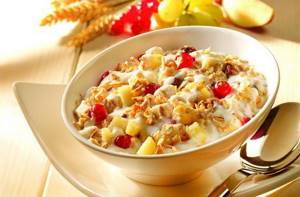
Here is an example menu for you:
- Breakfast: oatmeal on water with pieces of dried fruit (150 grams);
- First snack before 12:00: one orange;
- Lunch: grilled fish (150 grams), a slice of whole grain bread, a salad of fresh cucumbers and tomatoes with herbs, dressed with olive oil;
- Second snack before 16:00: low-fat yogurt without sugar;
- Dinner: salad of leafy vegetables with shrimp, seasoned with lemon juice, a handful of oat bran.
As you can see, the diet complies with the rules of both the classical and new pyramids. The basis is cereals and fresh fruits, there is one serving of protein and dairy products. There is very little fat.
The food pyramid combines the main principles of a healthy menu in one small picture. It is easy to use, and thanks to its flexible rules, it allows you to create an individual program taking into account age, health status, physical activity and other factors. There are no pseudoscientific distortions in the pyramid that many express diets suffer from.
Always remember that proper nutrition is the easiest and safest way to achieve a beautiful appearance and a slim figure.
List of sources used in writing the article:
- Jesse Russell, The Food Pyramid, Book on Demand, 2013.
- “Dietetics. Leadership", ed. Baranovsky A.Yu., Peter Publishing House, 2021.
- W. Willett, P. Skerrett “The Chemistry of Healthy Eating”, Potpourri Publishing House, 2014.
- https://www.hsph.harvard.edu/nutritionsource/healthy-eating-plate/.
- https://www.choosemyplate.gov/WhatIsMyPlate.
- https://www.ncbi.nlm.nih.gov/pubmed/26590418.
Drawing ideas about healthy eating, grade 2
More complex pictures are suitable for an eight-year-old child. At this age, the drawing should tell children the benefits of healthy eating. For example, you can depict two guys.

The first one is weak and lethargic, he became like this because he eats bad food. The second one is strong and playful, you need to draw good products next to it.
MyPyramid
Time passed, new research was carried out, and in 2007 a new version of the healthy person’s nutrition pyramid appeared. Its name is MyPyramid.
The basic principles of this pyramid:
- physical activity;
- proportionality;
- individuality;
- moderation;
- diversity.
Physical activity. When compiling a daily diet, it is necessary to take into account the principle of physical activity. That is why the picture shows a man climbing the stairs
It is important to move and be physically active every day. Advice from nutritionists - devote at least 60 minutes a day to sports
If you can't go to the gym or group fitness classes, then try to walk more.
Proportionality. This principle is reflected in the width of the pyramid segments and the ratio of products. For example, fats are allocated the narrowest segment. Therefore, their amount in the diet should be kept to a minimum.
Individuality. One of the advantages of the modified pyramid is the ability to create your own diet, taking into account the individual characteristics of the body. Each has its own “bouquet” of health problems, age, gender and taste preferences. A man in his prime who regularly lifts weights should eat differently than a lady of Balzac's age.
Moderation
It is important to always observe the principle of moderation in everything. What is its essence? Everyone knows that vegetables are beneficial and a source of vitamins.
They do not damage your figure, health and do not cause heaviness in the stomach. But this does not mean that they can be consumed in large portions and in unlimited quantities. Therefore, the measure must be observed not only in relation to harmful products, but also to useful ones.
Diversity. The principle of diversity states that products from any segment of the pyramid have the right to occupy their niche in the daily human diet. As you can see, in the photo each segment is painted in an individual color. The colors are represented by a specific product group. Let's look at them in more detail.
- Orange. This segment includes cereals, or more precisely: whole grain pasta, wholemeal bread, brown rice, bran, cereals. All products in the orange segment are rich in vitamins, low in fat, vegetable protein, dietary fiber, minerals and are “complex carbohydrates.” They must be present in the diet for a healthy diet every day. The creators of MyPyramid claim that the maximum number of servings of “orange” foods is 200 grams per day, half of which should be whole grain dishes.
- Green. Vegetable color. It is not for nothing that it is green, since today it is green vegetables that reign in smoothies, salads, first and second courses. They can be prepared for breakfast, lunch and dinner. An obvious plus, in addition to the benefits and lack of calories, is compatibility with products from any other segment of the pyramid. The maximum amount of “vegetable” serving is equal to 2.5 cups per day (500 – 600 grams). In addition to green vegetables, you need to choose vegetables in yellow and orange shades.
- Red. Berries and fruits. They provide the necessary portion of beta-carotene, plant pigments, iron, vitamin C, organic acids, fiber and folic acid. Two servings of fruit every day will provide you with natural vitamins and minerals. Focus on one serving of citrus fruits and avoid fruits that have a high glycemic index. They are best taken after training. And don't go too heavy on fruit juices. Instead, eat whole fruits that contain fiber.
- Blue. Dairy products, which are considered to be an irreplaceable source of animal protein and calcium. They are also rich in B vitamins, vitamins A, D and E, iodine, zinc, phosphorus. Another bonus of dairy products is bacteria that are beneficial for the intestines. They contribute to the normalization of its detail, creating conditions for stable work for the benefit of the whole organism. Advice from nutritionists - three servings of milk every day.
- Yellow. Fats are a very small part of the diet. Preference should be given to vegetable fats and oils. The first rich in nuts and grains. The second ones include the most useful: olive, flaxseed, sesame and unrefined sunflower oil. But try to forget about the harmful ones. If it doesn’t work out, then limit it as much as possible. This includes trans fats. By the way, I have an interesting exposé article about them:
Violet. Plant products – legumes and nuts. Animals – meat, poultry, eggs and fish. As you know, animal proteins are a source of essential amino acids. Fish enriches the body with omega-3 and omega-6. They remove cholesterol and saturated fats. The healthiest varieties are salmon, trout and herring.
The principle of building a pyramid
In its widest lower part there are products of daily consumption, which make up the bulk of the recommended diet. In its original form, the lower part was occupied by grains, flour products, cereals, and starches. Above were vegetables and fruits. On the third tier, scientists placed meat, fish, and dairy products. The top of the pyramid was headed by sweets and fats, both animal and vegetable origin.
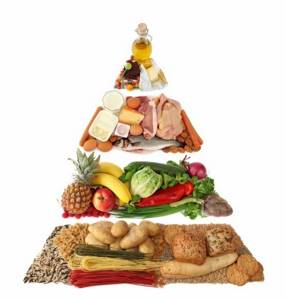
Time has made corrections to the structure of the scheme. Taking into account new research data that showed the effect of starches on weight gain, they were moved from the bottom of the pyramid between sweets and milk. And the bottom was occupied by whole grain products and vegetable fats, which should make up the bulk of a proper diet.
The new version of the Harvard Pyramid has the following structure:
- At the bottom there was a reminder about the need for daily physical activity and weight control;
- followed by daily consumption products, which include whole grain products and vegetable fats;
- the next tier - vegetables, fruits in the size of two to three servings, which is about three hundred grams;
- Even higher are the sources of vegetable protein - nuts, legumes;
- fish, poultry, eggs and dairy products can be consumed up to two servings per day, choosing one product;
- the top is still headed by sweets, to which starchy foods (rice, potatoes, white bread) and red meat with butter have been added.

Top-ranked foods should be limited to twice a week. Separately, on the side, information is provided on moderate alcohol consumption. It is recommended to take vitamins without fail.
Other types of food pyramids and their differences
In 2005, American scientists published a new pyramid, MyPyramid, which is aimed at providing modern man with the opportunity to create his own diet. The familiar pyramid was made up of multi-colored sectors converging to the top. The width of the sector depends on the recommended share of products in the daily diet. A significant part consists of vegetables, fruits, cereals, and dairy products. There was no room for sweets in it. A man running up the steps reminds us of the need to maintain a balance between energy expenditure and consumption.
Taking into account the need to instill the rules of healthy eating from childhood, a pyramid of proper nutrition for children was developed. It clearly shows a list of useful products and the need for outdoor games.
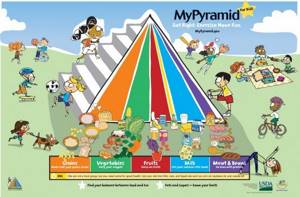
Among other types of food pyramids, it is worth noting the Mediterranean, vegetarian, and Asian ones, which take into account the nutritional characteristics of residents of different countries of the Earth. The vegetarian food pyramid is presented both in its traditional form, where meat products, eggs, fish, and milk are excluded, and as the Linda scheme. It is supplemented with dairy products and eggs two to three times a week. The basis of the vegetarian pyramid is made up of beans, vegetables, fruits, and whole grains, which are consumed daily.
The Mediterranean pyramid is based on rice, pasta, bread and potatoes. The second tier traditionally contains vegetables and fruits. Olive oil, cheese and yogurt are consumed daily. Several times during the week you can eat fish, poultry, eggs and sweets. But it is recommended to limit red meat to a few servings per month.
But no matter what healthy eating plan you choose, its main purpose is to help everyone independently plan their menu in accordance with the rules of healthy eating.
https://youtube.com/watch?v=Bp-IXulvh1E
- Healthy nutrition for children (+ menu)
- Basic principles of healthy eating
- Proper diet (+ menu for the week)
Stages of the food pyramid
The nutrition pyramid for a healthy person consists of four steps:
- base;
- second stage;
- third stage;
- top.
Let's look at each of them separately.
Base
The base of the pyramid consists of three food groups that should be found in the diet, if not daily, then as often as possible.
| Group | Products | Why is it necessary? |
| Vegetables and fruits | All fruits and vegetables | They contain a lot of fiber, which slows down the absorption of food; vegetables promote better protein digestion. |
| Vegetable unsaturated fats | Corn, sunflower, rapeseed, flaxseed, olive oil | Promotes rapid muscle recovery after intense training and reduces cholesterol levels. |
| Whole grains (complex carbohydrates) | Wholemeal bread, durum wheat pasta, cereals, brown rice | Provides the body with nutrients and contains minimal sugar |
Second stage
| Type of proteins | Products | Why is it necessary? |
| Vegetable | Seeds, nuts, legumes, lentils, beans, chickpeas, mushrooms | Contains protein and a large amount of fiber, which has a beneficial effect on intestinal function and is used in many weight loss programs. |
| Animals | Meat, fish, poultry, seafood, eggs, chicken | Contains all essential amino acids. |
Third stage
Includes milk and products containing it, which can be kefir, cottage cheese, cheese, etc. These products are a source of many vitamins and microelements, and they also contain complete animal proteins. If you are lactose intolerant, regular milk can be replaced with soy or almond milk.
Top
The top has absorbed those products that need to be reduced to a minimum. These include:
- animal fats;
- simple carbohydrates;
- sweets;
- baked goods made from white flour;
- alcoholic products.
You should also not get carried away with potatoes - they contain too much starch.
Each food group can be divided into portions. Determine your daily caloric intake based on gender, age and activity level to determine the number of servings and their size. Thus, when focusing on groups, food portions can be expressed as follows:
- grains - a slice of bread, 100 grams of porridge or pasta, 2-3 oatmeal cookies;
- vegetables - half a glass of raw or boiled vegetables, a glass of vegetable juice;
- fruits – one any medium fruit, a glass of fruit juice;
- proteins - 100g of meat, 3 eggs, three-quarters of a plate of beans;
- dairy products - a glass of milk, a couple of slices of cheese, a third of a pack of cottage cheese;
- top - 2 tablespoons of sugar, 30 grams of butter.
Diversity of the healthy human food pyramid
The basic principles of the food pyramid of a healthy person were selected by nutritionists in order to make proper nutrition as varied as possible.
The ability to consume various types of foods that do not cause allergies and other acute reactions of the body allows the person losing weight to maintain a morally comfortable state, which contributes to longer compliance with the rules in the preparation of the diet.
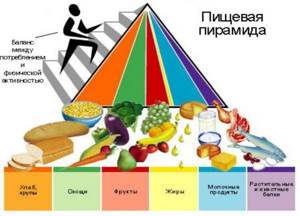
All permitted products are grouped by color:
| Subgroup color | Description of the subgroup |
| Orange | Products included in the orange subgroup are cereals. They enrich the body with vitamins, minerals, fiber and vegetable protein. |
| Green | Includes all permitted vegetables except red ones. The recommended number of servings is from 3 to 5 per day. |
| Red | Includes fruits and red vegetables. Saturates the body with plant fiber, beta-carotene, vitamin C, folic acid, and microelements. |
| Yellow | Includes sources of vegetable fats. The volume of consumed products from this subgroup should be minimal. Otherwise, a person’s risk of developing cardiovascular diseases increases sharply. |
| Blue | The subgroup consists of dairy products that saturate the body with lactobacilli, bifidobacteria and animal proteins. |
| Violet | The purple step of the food pyramid consists of sources of plant and animal proteins. It is not recommended to consume semi-finished products and products made from meat by-products. |
Vegetarians have their own pyramid
The vegetarian food pyramid, unlike the traditional ones, does not insist that you can eat well only if you eat meat and milk, poultry, fish and eggs.
The basis of a vegetarian’s diet, according to the pyramid, is cereals in combination with legumes and cereals.
Animal protein contained in meat includes the entire necessary set of amino acids, while plant foods lack one or the other. Therefore, only by combining and consuming beans and grains at the same time, vegetarians can compensate for the deficiency of amino acids in the body.
The second most important thing in a vegetarian's diet are vegetables and fruits. Protein-rich foods are the third step of this pyramid.
This includes cheese, eggs, milk or low-fat cottage cheese, soy products, seeds and nuts
Food rich in protein is the third step that this pyramid includes. This includes cheese, eggs, milk or low-fat cottage cheese, soy products, seeds and nuts.
Well, at the very top are fats and sweets. You shouldn’t completely remove them from your diet, because they contain many useful substances. It is better to choose them wisely.
From fats, you can consume unrefined vegetable oil and ghee. And for sweets you can eat dark chocolate and dried fruits.
What is the healthy eating pyramid (food pyramid) and its basic principles
Excellent nutrition method. I only lean towards her. This is where you can really lose weight and not lose your health. They say correctly that you don’t need to go on a diet that you won’t be able to stay on for the rest of your life. If you look at it this way, then this diet cannot be called poor for losing weight. For example, if there are 11 servings somewhere on average of a gram, then in a day you get more than 2 kilograms of food.
This site uses Akismet to reduce spam. Find out how your comment data is processed. Home Diets. The diet includes a hamburger, fries, etc. There are also no restrictions on meat consumption per week.
steps
The food pyramid consists of 4 main steps.
Base
The base of the food pyramid is made up of the 3 largest food groups.
Nutritionists recommend including them in your diet daily or every other day:
- sources of complex carbohydrates (this subgroup includes whole grain products, which provide the body with useful microelements that improve the functioning of internal organs and strengthen the immune system);
- vegetables and fruits in any form of consumption (these products saturate the body with the necessary amount of fiber. Vegetables and fruits also reduce the rate of food absorption, which ensures complete digestion of healthy protein foods);
- unsaturated vegetable fats (this category includes the most useful varieties of vegetable oils extracted from corn, sunflowers, flax and olives. Vegetable fats not only reduce the concentration of harmful cholesterol in human blood, but also contribute to the rapid restoration of muscle fibers, which is especially necessary for athletes, practicing strength training).
Vitamin and mineral level
The vitamin and mineral stage of the food pyramid is formed by:
- low fat milk;
- cottage cheese no more than 1-3% fat content;
- low fat yogurt;
- cheese (preferably curd or hard varieties);
- kefir with low fat content.
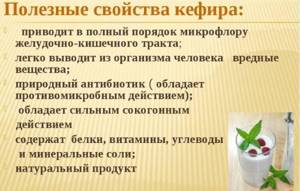
It is necessary to consume dairy and fermented milk products, since they are the main source of complete animal proteins. If there are allergic reactions to the composition of milk and its industrial products, the classic cow drink is replaced with soy, coconut and almond.
Protein stage
The protein stage of the food pyramid consists of products of various origins.
They are divided into main groups:
- vegetable (for example, cereals, legumes, mushrooms, etc. They saturate the body with proteins and dietary fiber, normalizing the functioning of the gastrointestinal tract);
- animals (for example, dietary meat, white fish, chicken, turkey, seafood, etc. Products included in this subgroup are the main suppliers of amino acids necessary for the normal functioning of the body).
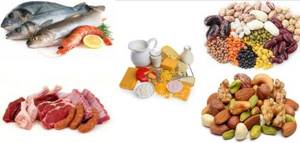
Dishes that include products related to protein sources must be consumed daily in quantities of no more than 50-100 g per day (in the absence of special recommendations from a doctor who has an understanding of the health of a particular person).
Vertex
At the very top of the food pyramid are foods whose consumption should be minimized not only by people trying to lose weight, but also by those who care about their health.
They are:
- potatoes and dishes containing them (due to the large amount of starch in their composition, potatoes are not recommended for use in the diet of those losing weight, as well as those who have gastrointestinal dysfunction);
- animal fats;
- fast carbohydrates (they are not only in the absolute majority deposited in the fat layer, but also affect level fluctuations);
- products with a high content of refined sugar;
- baking from regular wheat flour (as an alternative, it is permissible to use whole grain rye flour or unleavened dough with corn or flaxseed flour);
- alcoholic drinks.
How to create the right diet?
If it is not possible to use the services of a specialist to draw up an individual food pyramid, it is recommended to organize your eating habits in accordance with the algorithm below.
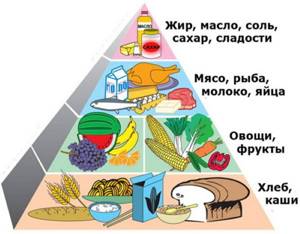
He is such a:
- The main section of the pyramid of a person seeking to maintain the existing state of his figure must be made of whole grains and cereals.
- The next group of products should be meat products, fish, nuts, eggs.
- Dairy products should be located on the penultimate step of the pyramid.
- It is recommended to minimize the amount of consumed flour products, sweets and fatty foods.
Based on the basic principles of the resulting pyramid, the menu for one of the days may look like this:
- medium-sized chicken egg - 1 pc.;
- olive oil (for example, for salad dressing) – 1 tbsp. l.;
- pine nuts – 10 – 15 pcs.;
- whole grain bread – 1 piece;
- steamed rice – 100 g;
- dry cereal flakes – 25 g;
- hard cheese – 35 g;
- dietary grade of meat (or poultry) – 120 g;
- vegetables and fruits in unlimited quantities (seasonal varieties are a priority);
- unlimited water;
- dairy and fermented milk products – 200 ml.
Nutrients
It is necessary to create a diet taking into account the correct proportions of nutrients. If a person's goal is to stay in shape, the optimal proportions of fat, protein and carbohydrates needed would be 20%, 20% and 60%, respectively.
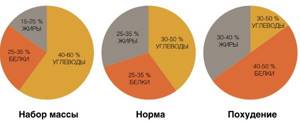
If dietary adjustments are made for the purpose of losing weight or building muscle mass, the shift in ratio must be calculated in conjunction with a fitness trainer or nutritionist (for example, for a healthy man 30 - 35 years old, seeking to build muscle, the daily menu should be 50% carbohydrates, 35% protein and 15% fat).
Water
The optimal amount of liquid drunk during the day should be calculated by a person using the formula: 30 ml of water * 1 kg of actual body weight. The bulk of the resulting amount of water should be consumed during the first half of the day. It is not recommended to drink 1 hour before bedtime to avoid the formation of puffiness under the eyes after waking up in the morning.
Calorie content
The daily calorie intake for maintaining physical fitness in men is calculated using the formula: 10 * actual weight (in kg) + 6.25 * actual height (in cm) – 5 * person’s age (in years) + 5.
The daily calorie intake for maintaining physical fitness in women is calculated using the formula: 10 * actual weight (in kg) + 6.25 * actual height (in cm) – 5 * person’s age (in years) – 161.
The principle of physical activity
In addition to the principle of diversity, the following principles are also characteristic of the food pyramid:
- The principle of proportionality. The point is that it is necessary to adhere to the correct ratio of foods consumed. In the diagram, this rule is reflected in the different widths of the segments. For example, the yellow segment of fats is the narrowest, which means that fats should occupy the very last place in the diet.
- The principle of individuality. Each person is individual. Moreover, this includes not only his gender, age, body structure, but also food preferences. The food pyramid will help you create an individual healthy diet.
- The principle of moderation. The correct diet is not only about the quality of the foods consumed, but also about their quantity. Moderate consumption means not overeating or starving.
- The principle of physical activity. This principle creates a parallel with the other principles and is represented by the formula: varied food physical activity = beautiful and healthy body. We'll talk about this principle in more detail a little later.
The food pyramid should not be taken as some kind of rigid guide to nutrition. From all the variety of products, everyone can create a suitable healthy menu for themselves. And the maximum effect of the health pyramid will only be achieved if the following conditions are met:
- Maximum combination of products.
- Balancing food intake with physical activity.
- Minimizing products from the top of the pyramid.
- Strict adherence to the choice of products from a specific group - there should be no substitution.
- Consume only fresh foods, avoiding prepared foods.
- A competent approach to purchasing products by studying their nutritional value and production date.
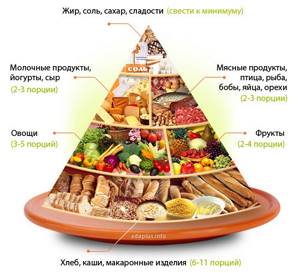
One of the principles of the healthy eating pyramid is the principle of physical activity. In the diagram he is represented as a man climbing the stairs. And the essence of this principle is that you can achieve a beautiful body only by combining a healthy diet with physical activity. Nutritionists advise devoting at least an hour a day to the latter.
And in order to replenish the calories lost during physical activity, you need to know how many calories you need to consume. So, for physically active people you will need 2800 kcal, and, for example, for pensioners or people leading a sedentary lifestyle - only 1600 kcal. Based on this, you need to build your diet, using all the principles of the pyramid.
If we take into account athletes who train intensively, they should base their diet on the basis of the following daily calorie values:
- 2500-2800 kcal – for women;
- 2800-4300 kcal – for men.
The healthy eating pyramid has undergone many changes: some adjustments have been made, both qualitative and quantitative, and additions have been made. The principles were also revised. Relatively recently, the principle of physical activity has even come to the forefront, pushing aside the principle of diversity.
Main rules of nutrition
- You must follow the rules of the food pyramid and try to bring your menu as close as possible to its principles. Despite the fact that few people manage to organize an ideal diet, these principles will help you introduce the most necessary products into the menu and remove junk food from it.
- It is important to strive to consume only fresh foods. If you can’t cook on your own, then you should choose high-quality semi-finished products. It is better to completely exclude food that is sold ready-made from the diet.
- To provide a truly balanced diet, the list of products must be quite wide. It should include all food groups, but the correct proportions of their consumption should be observed.
- You should use healthy foods as snacks - nuts, fruits, dried fruits.
- Cabbage is a dietary vegetable that should be included in the diet as often as possible. Any type of cabbage - red, white, savoy, kohlrabi, Brussels sprouts, Peking cabbage - is not only rich in vitamins, but also helps reduce the risk of a number of diseases.
- If possible, you should choose low-fat foods. You also need to reduce the amount of sugar, salt and alcohol in your daily diet.
- One of the most important rules is that the food consumed is consistent with physical activity. Excess calories invariably leads to excess weight.
- The benefits of a healthy diet are undeniable. But you shouldn’t expect instant results from switching to a healthy diet. Gradually, a person still notices very important changes for him: normalization of sleep, improved performance, normalization of weight, etc.
Harvard Pyramid 1992
This food pyramid was developed in 1992 by nutritionists at the Harvard School of Nutrition in the USA. This was the first option, and it looked like this: several tiers (like shelves in a closet) and the amount of food that you need to eat every day. At the foot of the pyramid there are daily sports exercises (exercises, jogging, etc.), and above, tier by tier towards the top of the pyramid there is food. Guys and men need approximately 2 liters of clean water per day, and girls and women need 1.5 liters of water. Alcohol should be limited, according to nutritionists from Harvard.
The foods in the food pyramid are arranged like this:
The 1st floor of the food pyramid is foods that need to be consumed every day in our lives. Complex carbohydrates: durum wheat pasta, wholemeal bread (not white), various cereals, brown rice, buckwheat, bran. Vegetable fats: olive oil, vegetable oil, rapeseed oil, corn oil, etc.
2nd floor - preferably fresh vegetables in abundance (cucumbers, tomatoes, radishes, onions, dill, herbs, lettuce, etc.). A variety of fruits (apples, pears, bananas, kiwis, grapefruits, tangerines, oranges, etc.), berries (raspberries, strawberries and others) - 2-3 servings per day.
3rd – Various nuts (cashews, walnuts, almonds, etc.), legumes (peas, beans, etc.) – 1-3 servings per day.
4th floor of healthy eating - fish (salmon, trout, etc.), chicken (preferably chicken fillet without skin and a minimum of animal fat), eggs, these products are 0-2 servings in the daily diet.
Level 5, approaching the top. Milk 0.5-1.5% fat and low-fat dairy products (ryazhenka, kefir, etc.).
Level 6 (top). Eat this food rarely, because... it is not useful. For children and for weight loss, the last thing you need to do is consume such food. Red meat, butter, sausages, margarine, potatoes, sweets, cakes, pastries, carbonated drinks, alcoholic drinks, white bread.

Vitamins and minerals can be added to your daily menu if you do not get enough vitamins from food. You can consult a specialist about additional vitamins in your diet. If you lead an active lifestyle, play sports or want to lose weight, most likely you can take vitamins in courses, as they have a beneficial effect on the body. Never self-medicate; it is better to consult a doctor or nutritionist.
Alcohol is harmful to your health, both for adults and children and for those who want to lose weight. Adults can rarely drink, preferably red wine. Take care of your health while you are young and energetic.
The basic principle of Harvard specialists is this: foods that are at the bottom of the pyramid should be consumed every day, evenly. And going from bottom to top, you need to reduce the amount of food per day. It is advisable to exclude or minimize those at the very top of the healthy menu pyramid altogether, because they do not bring any benefit to you (for children and for weight loss, you need to exclude them 100%).
Drawing ideas 3rd grade
Starting from the third grade, the drawing should tell about the beneficial properties of the food that the child eats. The theme of the pictures could be the composition of the products. Children should be told which foods contain vitamins and other healthy substances.
For example, make a still life of fruits with vitamin C:
- Orange.

- Lemon.
- White cabbage.
- Black currant.
- Cranberry.
Food pyramid MyPyramid. Improved development of American nutritionists
Over the two decades of its existence, the pyramid described above has been repeatedly refined and improved. The latest and most current version is considered to be the MyPyramid pyramid, which appeared ten years ago. It was created as a government program implemented in the United States with the assistance of the Department of Agriculture.
The difference between this pyramid and the previous one is that it does not represent a hierarchy of nutrition with vegetable fats and complex carbohydrates at its core. She proclaims five most important principles for building the right diet, according to which it should be:
- varied;
- individually composed;
- proportional to the age, weight and health of a particular person;
- moderate;
- taking into account physical activity.
The pyramid has several segments, each of which is painted a different color. They indicate groups of products recommended for consumption:
- the orange sector includes cereals, which contain no fats, contain minerals and vitamins, as well as vegetable protein and healthy dietary fiber;
- the green sector is represented by vegetables;
- the red sector is all the variety of fruits and berries;
- the yellow sector means fats, which should be predominantly vegetable or entered into the body with fish dishes;
- in the blue sector - milk and other dairy products;
- The purple sector includes meat and fish products, as well as beans, nuts and eggs.
An adult can eat up to six servings of grains, up to five servings of vegetables and three of fruits, as well as up to three servings of dairy or fermented milk products and up to three servings of products from the purple sector every day.











